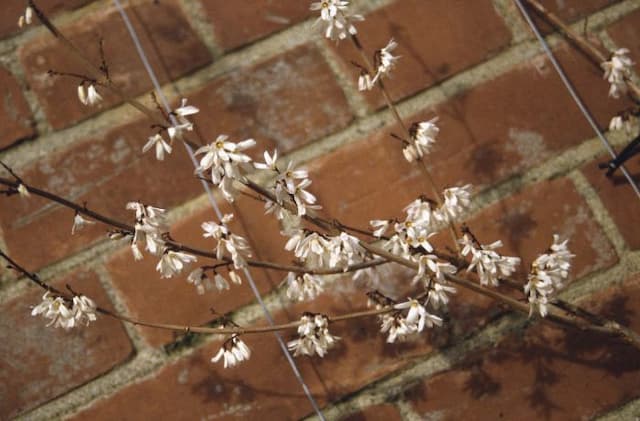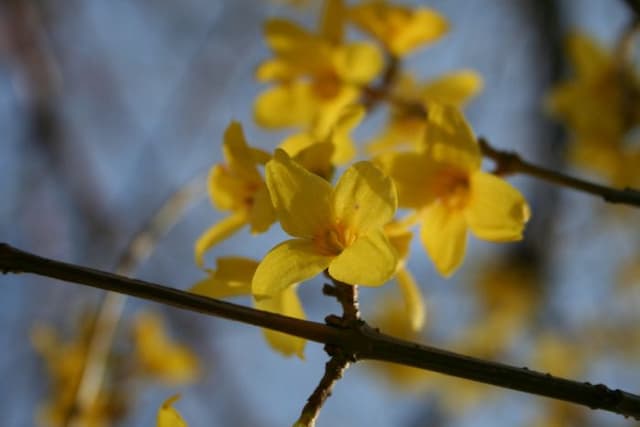Bloomerang Lilac Syringa Bloomerang Dark Purple = 'Smsjbp7' (PBR)
![lilac [Boomerang Dark Purple]](/_next/image?url=https%3A%2F%2Fplants-admin.emdemapps.com%2Fimages%2Fplants%2F%2Fimages%2F607ea3ef9ba0a.jpg&w=3840&q=75)
ABOUT
The Syringa Bloomerang Dark Purple, commonly known as the reblooming lilac, boasts an attractive and lush appearance. It is distinguished by its exceptionally dark purple flowers, which form dense clusters known as panicles. These blooms exude a delightful fragrance, characteristic of lilacs, that can perfume the surrounding air, and their deep color can add a dramatic touch to any landscape. The leaves of this lilac are heart-shaped with a smooth texture, exhibiting a fresh green color that contrasts beautifully with the dark purple flowers. This plant is a deciduous shrub, meaning it sheds its leaves annually but will regrow them each spring, providing seasonal interest. The reblooming lilac's unique feature is its ability to flower not just once in spring but to continue to produce blooms intermittently until the first frosts of fall, bringing extended color and fragrance to gardens. Overall, this variety of lilac can serve as an enchanting focal point in garden designs due to its distinctive color and repeat blooming habit.
About this plant
 Names
NamesFamily
Oleaceae.
Synonyms
Bloomerang Dark Purple Lilac, Reblooming Lilac, Dark Purple Bloomerang Lilac, Bloomerang Lilac.
Common names
Syringa Bloomerang Dark Purple = 'Smsjbp7' (PBR).
 Toxicity
ToxicityTo humans
The common name for Syringa Bloomerang Dark Purple = 'Smsjbp7' (PBR) is lilac. Generally, lilacs are not considered toxic to humans. They are commonly grown in gardens for their fragrant flowers and there are no widely recognized symptoms of poisoning from ingesting parts of this plant. It is always advisable, however, to discourage children from eating any plant material, as individual reactions can vary and it is better to err on the side of caution.
To pets
The common name for Syringa Bloomerang Dark Purple = 'Smsjbp7' (PBR) is lilac. Lilacs are not known to be toxic to pets. Both dogs and cats can tolerate small amounts of lilac ingestion without any significant poisoning symptoms. However, as with any non-food plant, ingestion of large quantities may cause gastrointestinal upset such as vomiting or diarrhea in some pets due to the plant matter and fiber content rather than specific toxicity. If your pet ingests a large amount of lilac, it is advised to monitor for any signs of illness and consult a veterinarian if any concerning symptoms appear.
 Characteristics
CharacteristicsLife cycle
Perennials
Foliage type
Deciduous
Color of leaves
Green
Flower color
Dark Purple
Height
4-6 feet (1.2-1.8 meters)
Spread
4-6 feet (1.2-1.8 meters)
Plant type
Shrub
Hardiness zones
3-7
Native area
Eastern Asia
Benefits
 General Benefits
General Benefits- Repeat Blooming - The Bloomerang lilac is known for its ability to bloom more than once in a season, typically in the spring and then again from mid-summer to fall.
- Fragrant Flowers - This plant produces highly fragrant, deep purple flowers that can freshen up any garden space with their delightful scent.
- Compact Size - With a mature height of about 4-6 feet, the Bloomerang lilac is ideal for smaller gardens or for use in residential landscaping.
- Attracts Pollinators - The flowers are attractive to butterflies and bees, which can help pollinate other plants in your garden.
- Low Maintenance - Once established, Bloomerang lilacs require minimal care beyond occasional pruning and are quite drought-tolerant.
- Deer and Disease Resistant - This specific variety of lilac is less palatable to deer and is resistant to common diseases that affect other lilac varieties.
- Year-Round Interest - With a combination of spring and summer blooms, as well as attractive fall foliage, this plant provides visual interest throughout multiple seasons.
- Adaptable to Various Soils - This lilac variety can thrive in a range of soil types, although it prefers well-drained, fertile soil.
- Easy to Propagate - Bloomerang lilacs can be easily propagated through cuttings, making it simple for gardeners to create more plants.
- Suitable for Hedges and Screens - Due to its dense growth habit, it can be planted in rows to create an effective and fragrant screen or hedge.
 Medical Properties
Medical PropertiesThis plant is not used for medical purposes.
 Air-purifying Qualities
Air-purifying QualitiesThis plant is not specifically known for air purifying qualities.
 Other Uses
Other Uses- Insect Attraction: Lilac's fragrant flowers can be used to attract beneficial insects such as butterflies and bees to the garden, promoting pollination in the garden ecosystem.
- Photography Backdrops: With their dense clusters of deep purple flowers, Bloomerang Dark Purple lilacs provide a stunning backdrop for portrait and macro photography.
- Artistic Inspiration: The vibrantly colored blooms can serve as a muse for painters and other visual artists, especially during the spring bloom season.
- Eco-Friendly Confetti: Dried lilac petals can be used as a biodegradable confetti alternative for celebrations and weddings.
- Culinary Decoration: Edible lilac flowers can be used to decorate cakes and desserts, adding a splash of natural color. However, it is important to ensure flowers have not been treated with pesticides.
- Natural Dye: The flowers of the lilac, when processed, can be used to create natural dyes for fabrics or crafts.
- Homemade Potpourri: Dried lilac blossoms can be included in homemade potpourri mixtures, contributing their pleasant fragrance to the blend.
- Crafting Material: Fresh or dried lilac twigs can be used as a base for crafting wreaths or other decorative items.
- Floral Arrangement: Lilac branches can be used in fresh floral arrangements, adding height and visual interest to bouquets.
- Garden Design: As a reblooming variety, Bloomerang Dark Purple lilacs can be strategically planted in garden landscapes to provide recurrent bursts of color.
Interesting Facts
 Feng Shui
Feng ShuiThe Lilac, being a flowering plant, can be used in Feng Shui to bring beauty, growth, and a strong yang energy to the garden. Its fragrance can also promote relaxation and stress relief. In Feng Shui, it's beneficial to place flowering plants like the Lilac in areas where you wish to introduce vibrant, uplifting energy, such as the wealth sector (southeast) or living spaces where the family gathers to activate positive chi (life force energy).
 Zodiac Sign Compitability
Zodiac Sign CompitabilityThe Lilac is not used in astrology practice.
 Plant Symbolism
Plant Symbolism- Renewal and Rebirth: The Bloomerang Dark Purple lilac, like other lilacs, symbolizes the return of spring each year, embodying ideas of renewal and new beginnings with its recurrent blooming pattern.
- Love: Lilacs are often associated with love and romance. The deep purple color of the Bloomerang Dark Purple lilac intensifies this symbolism, with purple traditionally linked to royalty and sometimes to deeper love or passion.
- Youthful Innocence: The sweet fragrance and delicate blossoms of lilacs can represent the innocence of youth or first love, reflecting fresh and naive emotions.
- Beauty and Pride: With its lush blooms and vibrant color, the Bloomerang Dark Purple lilac can symbolize the beauty of nature and might be associated with feelings of pride, reflecting the beauty one carries within.
- Nostalgia and Memories: Lilacs are often reminiscent of past memories and can conjure nostalgia, perhaps due to their presence in many gardens and their distinct, memorable scent.
- Spirituality: In some cultures, the lilac is considered to have a spiritual essence, and its presence in a garden is thought to bring peace and tranquility.
 Water
WaterThe Bloomerang Lilac ('Syringa Bloomerang Dark Purple') prefers consistently moist but well-draining soil. During the growing season, water this shrub once a week with about 1 to 1.5 gallons of water per session, ensuring that the water penetrates deeply into the soil to encourage strong root development. In periods of drought or extreme heat, you may need to water twice a week, but always check the soil moisture before watering to prevent overwatering. During winter, reduce watering as the plant's water needs decrease. Avoid overhead watering to prevent disease, and instead, water at the base of the plant.
 Light
LightFor optimal growth, the Bloomerang Lilac should be planted in a location that receives full sun, which means at least 6 hours of direct sunlight per day. Partial shade is tolerable, but flowering may be reduced. This particular lilac variety thrives with ample sunlight, which helps to produce the vibrant purple blooms and supports overall plant health.
 Temperature
TemperatureThe Bloomerang Lilac is hardy and can withstand temperatures as low as -20°F to -30°F, making it suitable for USDA Hardiness Zones 3 to 7. It prefers a temperate climate and will bloom most prolifically in conditions where the average temperature is moderate. The ideal temperature range for this lilac would be between 60°F to 75°F, where it can experience a distinct period of winter chilling required for optimal bloom production.
 Pruning
PruningPrune the Bloomerang Lilac immediately after the spring flowering concludes, removing spent blooms to encourage reblooming. This variety can also be lightly pruned to maintain shape and promote more vigorous growth. Annually, remove any dead or diseased branches, as well as those that are crossing or crowded, to improve air circulation and overall plant health. Pruning is also best done to rejuvenate older plants by removing a few of the oldest stems at the base, which encourages new growth for future seasons.
 Cleaning
CleaningNot needed
 Soil
SoilThe Bloomerang Lilac prefers well-draining, fertile soil with a pH range of 6.0 to 7.0. A good mix might include loam, peat moss, and perlite to optimize drainage and fertility. Mulching can help retain moisture and provide nutrients.
 Repotting
RepottingBloomerang Lilacs, being shrubs, are not commonly repotted. They are typically planted in the ground and may only need transplanting if they outgrow their space or for garden design reasons.
 Humidity & Misting
Humidity & MistingBloomerang Lilacs thrive in average outdoor humidity levels. They do well in typical garden environments without the need for additional humidity adjustments.
 Suitable locations
Suitable locationsIndoor
Ensure bright light and cool temps.
Outdoor
Plant in full sun, well-drained soil.
Hardiness zone
3-7 USDA
 Life cycle
Life cycleThe Bloomerang Dark Purple lilac begins its life as a dormant bare root or potted plant, which when planted in early spring, starts to develop a sturdy root system. As the weather warms, it breaks dormancy, sprouting green foliage, followed by robust stems. It then enters the vegetative stage, producing lush, heart-shaped leaves in preparation for its distinct blooming phase. The bloom stage occurs in late spring, where it showcases fragrant, deep purple panicle-like flowers, which can re-bloom periodically throughout the summer and into fall. Post-blooming, the plant enters a phase of seed formation and eventual dispersal if conditions allow, though cultivated varieties are often propagated vegetatively. As temperatures drop in autumn, the Bloomerang lilac prepares for winter dormancy, shedding leaves and conserving energy within the roots for the next growing season.
 Propogation
PropogationPropogation time
Spring
The Syringa Bloomerang Dark Purple, commonly known as the reblooming lilac, is best propagated through softwood cuttings. This method typically takes place in late spring or early summer when the new growth is still tender and green. To propagate, a cutting of about 4 to 6 inches (10 to 15 cm) is taken from a healthy branch, making sure there are at least two to three leaf nodes present. The lower leaves are stripped off, and the base of the cutting is treated with a rooting hormone to encourage root development. The cutting is then inserted into a well-draining potting mix, with care taken to keep the soil consistently moist but not waterlogged. A plastic cover or dome can be used to retain humidity, which helps improve the chances of rooting. Cuttings generally take several weeks to root and, once established, can be transplanted into the garden.

![Forsythia [Marée d'Or]](/_next/image?url=https%3A%2F%2Fplants-admin.emdemapps.com%2Fimages%2Fplants%2F%2Fimages%2F604b5d7568293.png&w=640&q=75)







